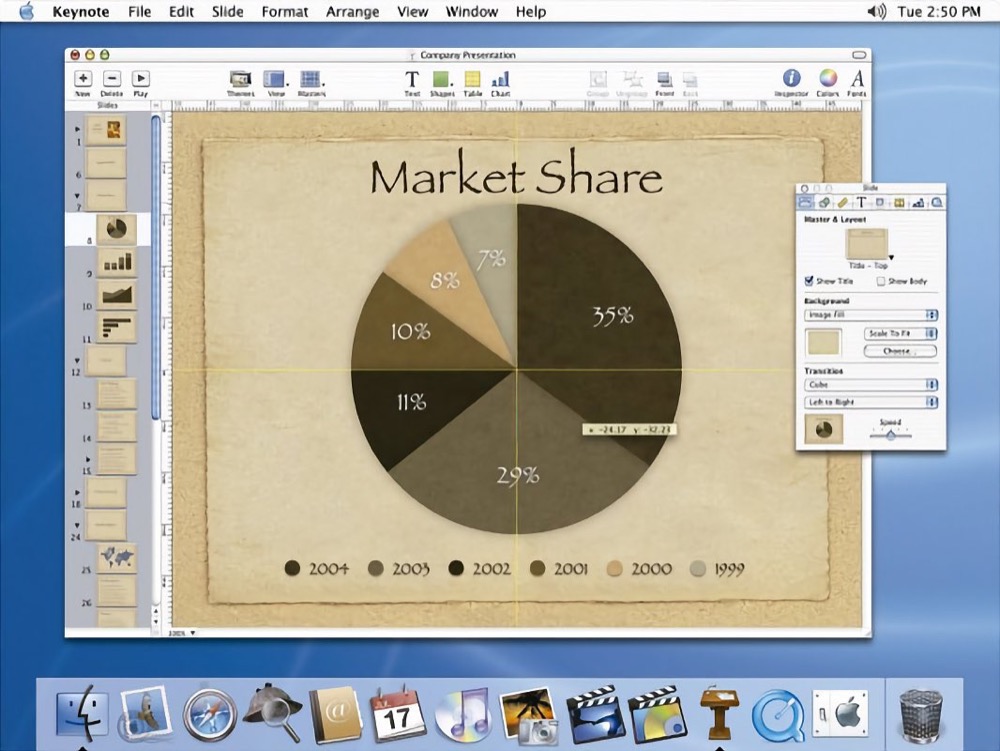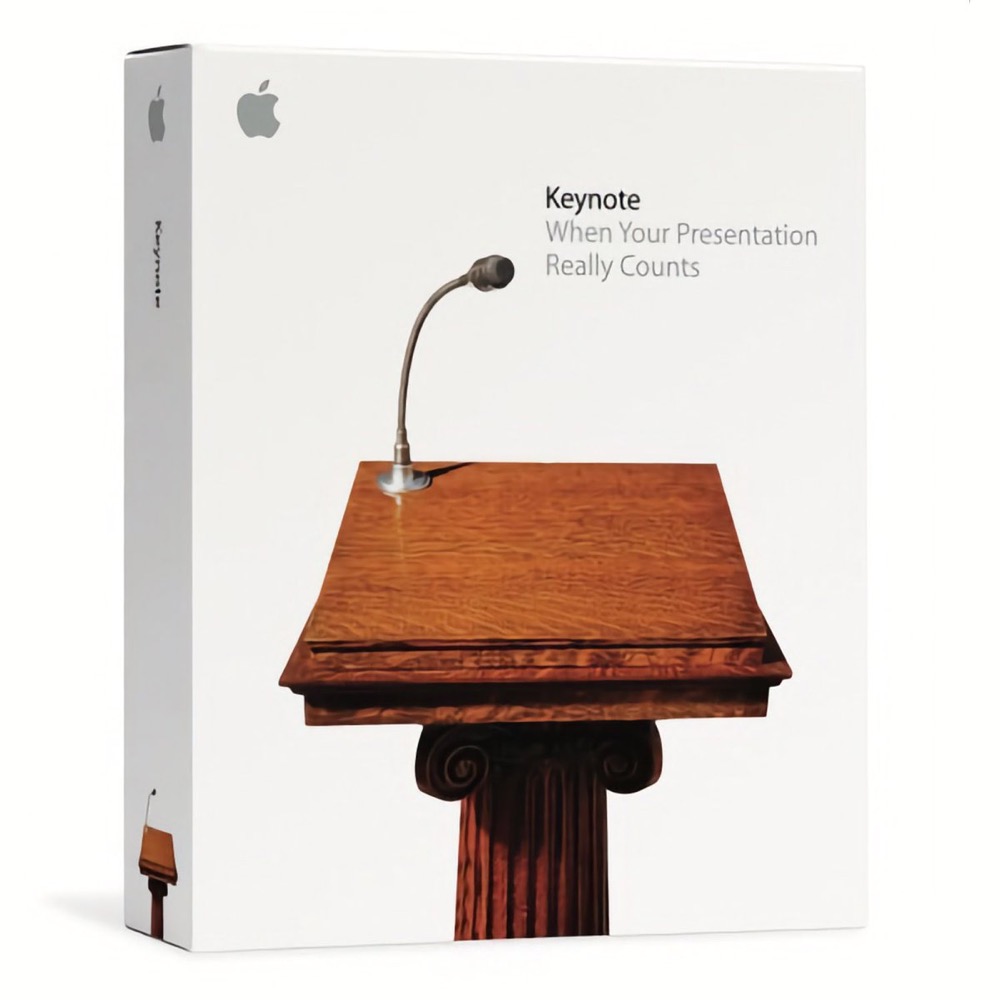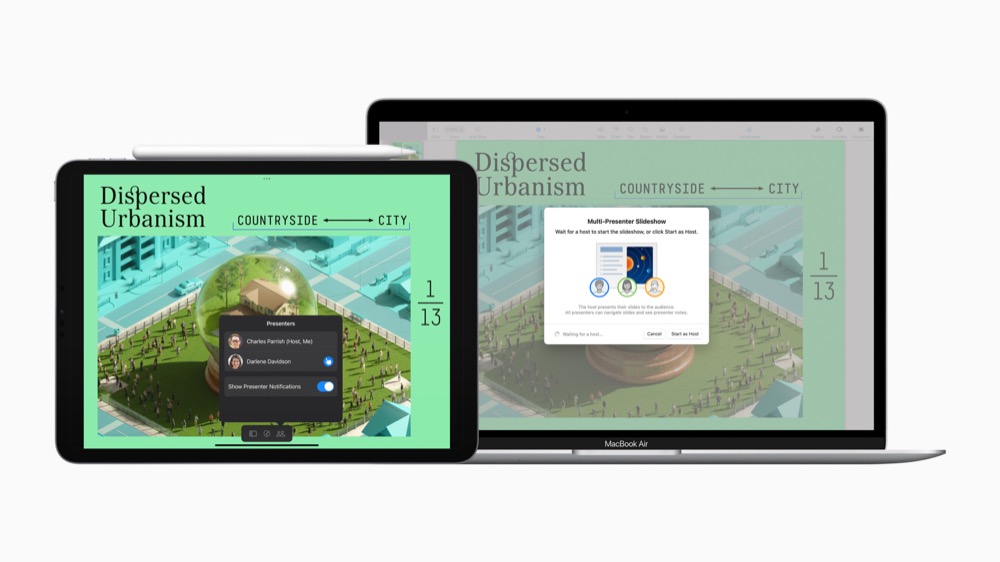Happy birthday Keynote — 20 years since it first appeared

The first Apple keynote shot underestimated the company’s eventual market share
It was twenty years ago pretty much to the day when Steve Jobs taught the world to make presentations the Apple way with the introduction of the Keynote app, originally built for the CEO.
Apple took a step into the yard
Way back when Apple was still working to convince people its easy-to-use Unix-based products could be used for proper work outside of the graphic design department, the company published the first of what would become its suite of iWork products, Keynote.
Originally (we think) developed as an in-house app for use by then CEO Steve Jobs during presentations and Keynotes, the app very quickly became a popular tool of choice for Apple users seeking an easier to use and Apple-native alternative to PowerPoint.
The app also had the advantage of great graphics and a slick UI. Introduced at Macworld 2003, 20 years ago, Jobs called Keynote a presentation app for when your presentation really counts.
“It was built for me,” he said. “I needed an application to build the kind of presentations I show to you at these keynotes,” he added. “We hired a low-paid beta tester to test the app for a whole year,” Jobs said, pointing to a picture of himself on the screen, before admitting he had secretly been using versions of the app to drive every keynote across the previous year.
https://youtu.be/ViWnJDomhsM
“Using Keynote is like having a professional graphics department to create your slides,” he said.
All about design and ease-of-use
At that time, the presentation app included 12 Apple-designed themes, all coordinated and built to exploit the Macs powerful advantages in video, typography and more. It made big use of Quartz and OpenGL for beautiful graphics. It also offered tools for tables, presentation navigation and more. At the time of its release, Apple charged $99 for Keynote.

This was the first Keynote box when it shipped on a CD
Two years later, Keynote was rolled into iWork 05, Apple’s productivity suite ‘for the rest of us’, which offered most of what y9ou need to make documents without use of Word.
This originally featured Pages and Keynote, and in 2007 grew to include spreadsheet app, Numbers.
Never one to leave a light secreted in the shadowy area under any passing bushel, Steve Jobs said at that time, “Numbers rounds out the iWork suite, which is far more intuitive and easier to use than anything else out there.”
The following year in 2009 Apple added all three apps to iCloud, providing a way Mac users could use its productivity apps online. Then, in 2010, Apple bought iWork to iOS when it pimped out its all-new iPad product with all three apps, though at a cost of $9.99 each. (Despite that cost, the apps gave thousands of execs queuing up to buy the Apple tablet an Office-compatible productivity suite they could use).
iWork came to iPhones and iPod touch the following year, in 2011, a year sadly marked by the departure of the world’s most famous Keynote beta tester from the global stage.

The world was moving on
Tech was transforming rapidly, and just as social media was all about collaboration, the workplace was also transforming so by the time 2013 came around it was vitally important that Apple introduce collaboration within Keynote, iWork, and iCloud.
This made it possible to work on a document on any of your devices, or to work with others on products. It was a subtle sign of what was to come in 2016 that Susan Prescott then VP Worldwide Appe Product Marketing took her first appearance at an Apple keynote to demonstrate the many improvements to real-time collaboration in iWork Apple wanted to talk about.
“There just wasn’t a great way to work… together,” she said, introducing real time collaboration in the apps, a collaboration that stretched across the whole platform. She also seized a moment to edit the live presentation deck while on stage.
Those steps showed how seriously the company had begun to consider the importance of creating platforms that could meet the more complex needs of enterprise productivity. A year later it made the apps available for free. Though, if we stop to think about it, Jobs’ revelation that Keynote reflected the needs of his company also ushered in this more evangelical approach to enterprise sales.
Naturally, development begins to accelerate. By 2018, iWork had drawing, book creation, Apple Pencil support, smart annotation and more, while 2021 saw Keynote gain what are in fact hugely powerful tools for collaborative presenting. This included support to offer a live camera view of the presenter directly within slides and multi-presenter controls.

[Also read: Apple just made Pages, Keynote & Numbers great again]
Enabling remote work and collaboration across its platforms
Of course, in a world of remote work and in conjunction with other Apple tools, including Continuity Camera, Freeform, Deskview, Support for Live video and multi presenter mode in Keynote, it’s pretty clear that Apple has a direction of travel to iWork. It appears to be on track to providing the world’s most accessible (because free) productivity platform that somehow manages to straddle the divide between the need for privacy and the urgent requirement to empower teams to collaborate, to work together apart.
Happy birthday, Keynote.
Please follow me on Mastodon, or join me in the AppleHolic’s bar & grill and Apple Discussions groups on MeWe.




